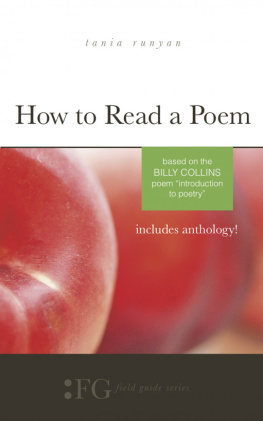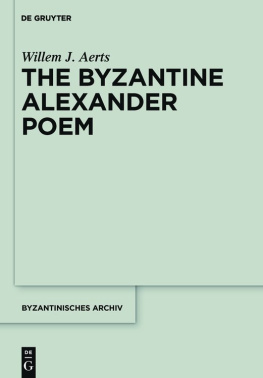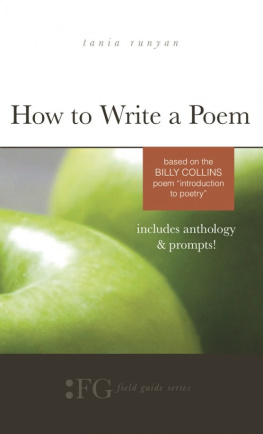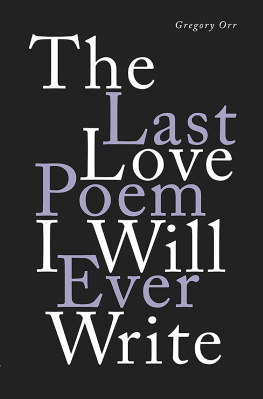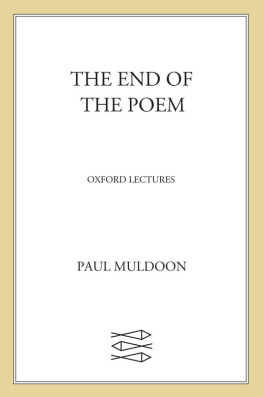Also published by Bloomsbury
British Childrens Literature and the First World War, David Budgen
The Late Cantos of Ezra Pound, Michael Kindellan
Modernism, War, and Violence, Marina MacKay
Perspectives on World War I Poetry, Robert C. Evans

BLOOMSBURY ACADEMIC
Bloomsbury Publishing Plc
50 Bedford Square, London, WC1B 3DP, UK
1385 Broadway, New York, NY 10018, USA
BLOOMSBURY, BLOOMSBURY ACADEMIC and the Diana logo are trademarks of Bloomsbury Publishing Plc
First published in Great Britain 2019
Copyright Oliver Tearle, 2019
Oliver Tearle has asserted his right under the Copyright, Designs and Patents Act, 1988, to be identified as Author of this work.
For legal purposes the constitute an extension of this copyright page.
Cover design: Anna Berzovan
Cover image No Mans Land (b/w photo of the battlefield in the Marne between Souain and Perthes, 1915) / Buyenlarge Archive / UIG / Bridgeman Images
All rights reserved. No part of this publication may be reproduced or transmitted in any form or by any means, electronic or mechanical, including photocopying, recording, or any information storage or retrieval system, without prior permission in writing from the publishers.
Bloomsbury Publishing Plc does not have any control over, or responsibility for, any third-party websites referred to or in this book. All internet addresses given in this book were correct at the time of going to press. The author and publisher regret any inconvenience caused if addresses have changed or sites have ceased to exist, but can accept no responsibility for any such changes.
A catalogue record for this book is available from the British Library.
Library of Congress Cataloging-in-Publication Data
Names: Tearle, Oliver, author.
Title: The Great War, The Waste Land and the modernist long poem / Oliver Tearle.
Description: London ; New York, NY : Bloomsbury Academic, 2019. | Includes bibliographical references and index.
Identifiers: LCCN 2018030084 (print) | LCCN 2018032211 (ebook) | ISBN 9781350027039 (ePub) | ISBN 9781350027022 (ePDF) | ISBN 9781350027015 (hardback)
Subjects: LCSH: World War, 19141918Literature and the war. | English poetry20th centuryHistory and criticism. | Modernism (Literature)Great Britain. | Eliot, T. S. (Thomas Stearns), 18881965. Waste land.
Classification: LCC PR605.W65 (ebook) | LCC PR605.W65 T43 2019 (print) | DDC 821/.91209358dc23
LC record available at https://lccn.loc.gov/2018030084
ISBN: HB: 978-1-3500-2701-5
ePDF: 978-1-3500-2702-2
eBook: 978-1-3500-2703-9
To find out more about our authors and books visit www.bloomsbury.com and sign up for our newsletters.
Contents
T. S. Eliot once remarked that no poet has his complete meaning alone, and it is as true of the critic as it is of the poet. My first debt of thanks, therefore, is to the numerous scholars, critics, biographers and literary historians whose work on T. S. Eliot and modernist poetry has helped to make researching this book so stimulating and enjoyable an experience. Closer to home, I must record a debt of thanks to my colleagues in the School of the Arts, English and Drama at Loughborough University, especially Anne-Marie Beller, Carol Bolton, Deborah Burton, Barbara Cooke, Andrew Dix, Nick Freeman, Karen Jarram, Paul Jenner, Sarah Parker and Helen Relf, and I am indebted to the staff of Loughborough University Library for helping me to locate some obscure and out-of-print modernist writings.
In addition, I would like to thank the many students I have taught over the last few years, for stimulating seminar discussions about Paris, Hugh Selwyn Mauberley and The Waste Land, especially those students on my undergraduate module The Modern Poet and the Mirrlees-Eliot sessions on the MA module Icons and Iconoclasts. I must record a special debt of thanks to my MA students, Matt Vallance and Anamarija Krassnig, for helpful and enjoyable discussions about Richard Aldington, Nancy Cunard and T. S. Eliot. I am also grateful to Keele University for inviting me to speak about Cunard and Eliot in April 2018 as part of their English research seminar series.
My thanks go to David Avital for having faith in this idea from the start and to the rest of the wonderful team at Bloomsbury. I am also indebted to the thoughtful comments from four anonymous reviewers who commented on the book.
Finally, thanks to Carole, Philip, Matthew and Rachel for support, encouragement and conversation while I was writing this book.
In the 1920s, a long poem was published, the most ambitious that its author had yet undertaken. It fused images of the First World War with the ancient world and descriptions of modern-day London. The poem is highly multilingual, alludes to numerous works of literature in different languages, and utilizes many different styles and forms, from rhyming couplets to snatches of popular song. The I who speaks in the poem is several different characters, who are all designed to represent one consciousness. The poem, in taking modern post-war Europe as one of its settings, attempts to speak for the world at large but is also a very personal depiction of a poets dissatisfaction with urban modernity and the loss of poetry in the new, post-war age. The process of writing the poem and confronting his own life and experiences led to the poet having a nervous breakdown.
All of this could apply to T. S. Eliots The Waste Land, a landmark work of modernist poetry published in 1922. But it might also apply to an altogether less well-known poem published three years later and written by a different modernist poet indeed, a poet who was uncomfortable with much of modernism by this stage of his career. The author of this other Waste Land was Eliots sometime friend and fellow modernist Richard Aldington, whose 1925 poem A Fool i the Forest was, in part, a response to Eliots more famous post-war poem about decaying Europe. Other poets including another of Eliots friends Ezra Pound as well as less celebrated writers such as Hope Mirrlees and Nancy Cunard would also write long poems in the modernist mode during the years immediately succeeding the end of the war. At least one of these, Hope Mirrleess Paris, was written three years before The Waste Land was published and anticipates Eliots poem in startlingly specific ways. Yet this history of the modernist long poem, which is so little known as to be almost a secret history, has not been told in full. This is surprising given the centrality of The Waste Land to our understanding of modernist poetry of the 1920s; yet Hope Mirrleess striking precursor to Eliots poem remains largely unknown, even among avid readers and students of modernist literature. This book tells the story of these other poems, and in doing so offers a significant and original contribution to our understanding of modernist poetry produced in the years following the Great War.
Why were modernist poets drawn to the long poem during the immediate post-war years? Stephen Spender recalled Eliot confiding to him that The Waste Land could not have been written at any moment except when it was written a remark which, while biographically true in regard to his own life, is also true of the poems time in European history after World War I. The sense that Western civilization was in a state which was the realization of historic doom lasted from 1920 to 1926. Pound and Hope Mirrlees, among others, demonstrate this. To treat


